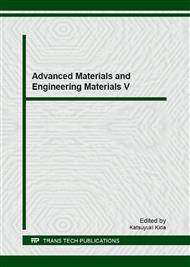[1]
Leonardo J D S, Flavia C A, Francisca P F. A review of the technological solutions for the treatment of oily sludges from petroleum refineries [J]. Waste management and research, 2014, 30 (10): 1016-1030.
DOI: 10.1177/0734242x12448517
Google Scholar
[2]
Hu G J, Li J B, Zeng G M. Recent development in the treatment of oily sludge from petroleum industry: A review [J]. Journal of hazardous materials, 2013, 261: 470-490.
DOI: 10.1016/j.jhazmat.2013.07.069
Google Scholar
[3]
Chen P, Kan L B. Research on the treatment of oily sludge [J]. Advanced materials research, 2013, 671-674: 2746-2749.
DOI: 10.4028/www.scientific.net/amr.671-674.2746
Google Scholar
[4]
Song W, Liu J G, Nie Y F, et al. Influencing factors and product property of low temperature pyrolysis of oil sludge [J]. China Environmental Science, 2008, 28 (4): 340-344.
Google Scholar
[5]
Andrey B, Svetlana B, David C L, et al. Sewage sludge-derived materials as efficient adsorbents for removal of hydrogen sulfide [J]. Environ Sci Technol, 2001, 35 (7): 1537-1543.
DOI: 10.1021/es001678h
Google Scholar
[6]
Fullana A, Conesa J A, Font R, et al. Pyrolysis of sewage sludge: NitroAgenated compounds and pretreatment effects [J]. Appl Pyrolysis, 2003, 68-69: 561-575.
DOI: 10.1016/s0165-2370(03)00052-4
Google Scholar
[7]
Yu L L, Zhong Q. Preparation of adsorbents made from sewage sludges for adsorption of organic materials from wastewater [J]. Journal of Hazardous Materials, 2006, 137 (1): 359-366.
DOI: 10.1016/j.jhazmat.2006.02.007
Google Scholar
[8]
Deng H, wang R S, Ren W, et al. Study on adsorptive capacity of pyrolytic residues of oily sludge [J]. Environmental Protection of Oil and Gas Fields, 2010, 20 (2): 1-3.
Google Scholar
[9]
Chen H Y, Yang Y J, Tan X D, et al. Preparation of adsorbent made from municipal digested sludge and its application [J]. Sichuan Environment, 2009, 28 (6): 5-8.
Google Scholar
[10]
Ma R, Lu X W, Dou Y Q, et al. Evaluating activated carbon for removal of natural organic matter in drinking water [J]. Safety and environmental engineering, 2006, 13 (2): 31-33.
Google Scholar
[11]
Zhang B, Pu H P, et al. The Manufacture and application research of sludge adsorbent with carbon [J]. Industrial safety and environmental protection, 2006, 32 (2): 32-33.
Google Scholar
[12]
Bagreev A, Bandosza T J, Locke D C. Pore structures and surface chemistry of adsorbents obtained by pyrolysis of sewage sludge derived fertilizer [J]. Carbon, 2001, 39 (13): 1971-(1979).
DOI: 10.1016/s0008-6223(01)00026-4
Google Scholar


